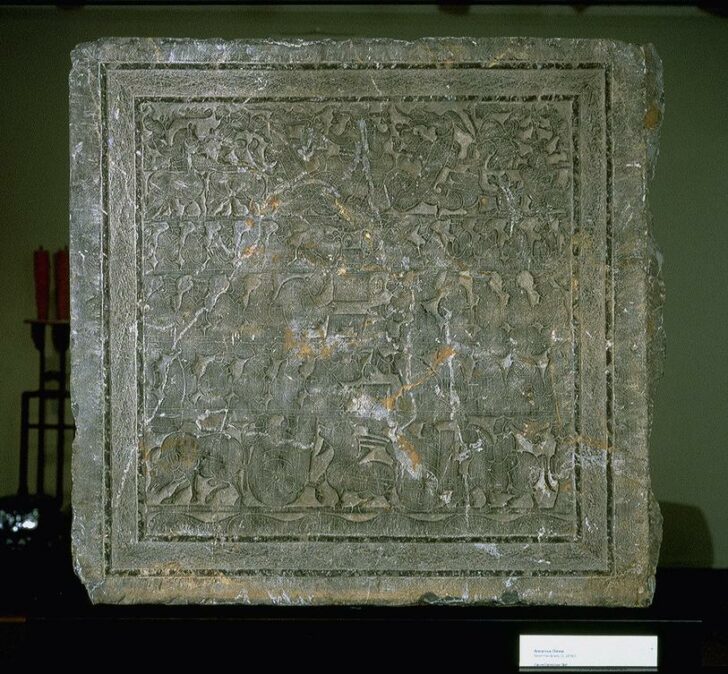Journey of the Soul to the Paradise of the Queen Mother of the West
Chinese

Description
This magnificent carved limestone slab was originally part of a memorial hall or tomb. It portrays the vertical ascent of the soul of the deceased from earth toward the “Happy Homeland” or heavenly abode of the Queen Mother of the West.
On the lower register of the carving, the soul of the tomb occupant rides in a chariot procession. The fish-inhabited waters indicate his earthly surroundings. In the central three registers the family and friends of the deceased are shown carrying out the proper funerary rites that will insure the success of his journey. The Queen Mother herself, shown as a winged creature with a human face, dominates the top row. She is flanked by two writhing dragons and other heavenly immortals, including two rabbits, who reside on the moon and are shown pounding rice cakes, and an auspicious nine-tailed fox, associated with the sun.
The Queen Mother of the West was the subject of a very popular cult during the Eastern Han Dynasty, when concerns about immortality reached a new and feverish pitch.
Maribeth Graybill, Senior Curator of Asian Art
Exhibited in "Flora and Fauna in Chinese Art," April 6, 2002 - December 1, 2002.
The Han imagination was simultaneously down-to-earth and preoccupied with immortality and other- worldly spirits. While the inexpensive mortuary pottery in the large wall case testifies to Han practicality, this carved limestone slab illustrates Han flights of fancy.
This magnificent square-shaped frieze was originally part of a memorial hall or tomb. Its seven horizontal registers portray the vertical ascent of the soul from the watery netherworld on the lowest register to the “Happy Homeland” or heavenly abode of the Queen Mother of the West at the top. In the widest register, above the watery netherworld of six swimming fish, is a burial procession lead by an ox cart—an accurate depiction of Han dynasty burial practice for the elite. The central three registers portray groups of mourners, performing rituals to send the deceased properly into the afterlife. The Queen Mother herself, shown as a winged creature with a human face, dominates the top register. She is flanked by two writhing dragons and other heavenly immortals, including a pair of rabbits who reside on the moon pounding rice cakes of immortality, and an auspicious nine-tailed fox, associated with the sun and magic.
The Queen Mother of the West appears in Chinese texts as early as the tenth century BCE of the Zhou dynasty (1027-256 BCE), but her cult became popular during the Eastern Han dynasty, when the desire for immortality reached a feverish pitch.
(Label for UMMA Chinese Gallery Opening Rotation, March 2009)
Subject Matter:
This magnificent carved limestone slab was originally part of a memorial hall or tomb. It portrays the vertical ascent of the soul of the deceased from earth toward the “Happy Homeland” or heavenly abode of the Queen Mother of the West.
On the lower register of the carving, the soul of the tomb occupant rides in a chariot procession. The fish-inhabited waters indicate his earthly surroundings. In the central three registers the family and friends of the deceased are shown carrying out the proper funerary rites that will insure the success of his journey. The Queen Mother herself, shown as a winged creature with a human face, dominates the top row. She is flanked by two writhing dragons and other heavenly immortals, including two rabbits, who reside on the moon and are shown pounding rice cakes, and an auspicious nine-tailed fox, associated with the sun.
The Queen Mother of the West was the subject of a very popular cult during the Eastern Han Dynasty, when concerns about immortality reached a new and feverish pitch.
Physical Description:
Limestone slab carved bas-relief with six registers. The lower register depicts a chariot procession above fish-inhabited waters. The central three registers depict figures carrying out funerary rites. The top register shows a winged creature with a human face flanked by two writhing dragons and other animals, including two rabbits and a nine-tailed fox.
Usage Rights:
If you are interested in using an image for a publication, please visit https://umma.umich.edu/request-image/ for more information and to fill out the online Image Rights and Reproductions Request Form.